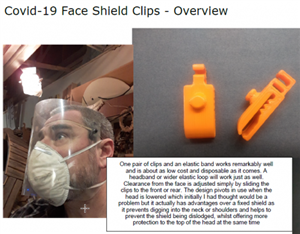CreativeImpulse:
Hi Kenneth,
My concern would be a microwave would destroy the static electric deposits that filter the viral load in the ones I mentioned. I think you'd need specialist knowledge of the mechanisms used to evaluate that with microwaves.
Regarding the cleaning of other types of mask and other PPE, I see no reason why that shouldn't be appropriate. If it were microwave proof, i.e. not going to shrivel up like a crisp packet... and didn't contain metallic hinge pins. Then in theory it should kill anything biological in pretty short order. That might offer an option for more delicate materials, the static based masks are quite solidly constructed from my brief reading. That's half the problem, you have to penetrate the mask to sterilise it at depth. However, something lighter and less solid, with no EM involvement should be suitable for a microwave. The question will be whether the Covid is heated due to it's own molecular construct/carrier construct being excited by the RF, or whether it is heated by the material it's on being heated. If the material has to reach high temperatures, that could be a problem. If the Covid itself is heated by the RF, then you could blast it quite quickly with an industrial microwave such as you'd probably find in most hospital kitchens.
Of course, we are in a hospital... we have X-ray generators! Could these be (ab)used?
I think at this point we need the input of an RF expert with biological expert.
Cheers
Rob
Kenneth Hattersley:
Good point. Has this ref any validity? https://consteril.com/covid-19-pandemic-disinfection-and-sterilization-of-face-masks-for-viruses/.
This claims the simple "single use" "mask is not cleanable but that two more complex masks are.
Does anyone know if a microwave would directly neutralise COVID19 (or other ) viruses held in fabric / plastic mask filters?
The reference above mentions microwaves in terms of generating heat from a water bath, on which a mask is placed.
If there was a clinically approved method it could be useful.
Hello Mr Phillips.
The use of Ozone for sterilization is new to me but of interest - potentially - for the sterilzation of face masks and other materiel - which has been a topic for a couple of us in this forum..
The premise is that if paper, plastic masks and eyeshields etc - even a proportion - could be recycled back into usage, this could save resources and help make kit available at this time of vast demand.
Using ozone would appear to be relatively low cost to generate and set up a sterilizing environment for smaller objects such as face masks, gowns, etc. using the Ozone Clean type equipment - if it works.
See this and other refs.. Are these trustable though - https://clinmedjournals.org/articles/jide/journal-of-infectious-diseases-and-epidemiology-jide-6-113.php?jid=jide
Would it be possible to ask of the MD what credible evidence there could be that Ozone works on fabrics, plastics (and other materials such as eye masks) with COVID-19? e.g are there any authenticated papers perhaps on neutralizing COVID-SARS -02? And if so what are the specifics however for achieving a sterilization environment - time / concentrations - could it be as simple as running the ozone generator in a chamber with the objects to be cleaned? If it works, what could be the downsides?
Hopefully regards, KenH
Ian Phillips:
Re: COVID-19: Call for rapid sanitising technology for ambulances.
To sanitise all the internal surfaces of an ambulance in significantly less time than 45min, calls for a gaseous solution, and high-levels of Ozone is the natural choice. Ozone is a naturally occurring oxidising gas, which can easily generated as required by using high voltage electricity. It is hazardous to most life-forms including bacteria and viruses and may be generated quite easily inside a confined room such as an ambulance ... and can be neutralised equally quickly for operator safety.
My research quickly lead to this wikipedia page on ozone and this Purozo page discussing the vulnerability of viruses to ozone. And then on to this company Ozone Clean, and its OC1500 Product. And on Sunday this week contacted the MD of the company, who confirmed everything that I hope for about ozone and their product ... including its immediate availability for trials. Ozone Clean is a UK company, the product was designed here and is made in England ... so is potentially readily scaled in production. Further, the MD is prepared to make a machine available immediately for trial.
... Naturally I will pass on the MDs contact details to anybody with serious interest.
This is equipment more usually used by general room cleaners for removing smells in hotel rooms and other public areas ... Indeed NHS is apparently already in possession of some of these, which it no doubt uses in this general cleaning role. But the potential to use this big machine in a smaller confined space to generate high levels of ozone is being overlooked; and repurposing it for sanitising is a very real and immediate possibility!
I realise that this is just a Forum, but I am finding it seriously difficult to talk to anybody about this idea! (I've been working on it for 5 days so far). The IET referred GOV.uk website links to a Defence and Security Accelerator (DASA) which is anticipating a Project Proposal; and the timescale associated with such, is not comparable with the Immediate Possibilities presented by this repurposing of existing equipment.
If any of you could suggest contacts or even champion it I (we) would be most grateful.
Thanks.ian :-)



We're about to take you to the IET registration website. Don't worry though, you'll be sent straight back to the community after completing the registration.
Continue to the IET registration site